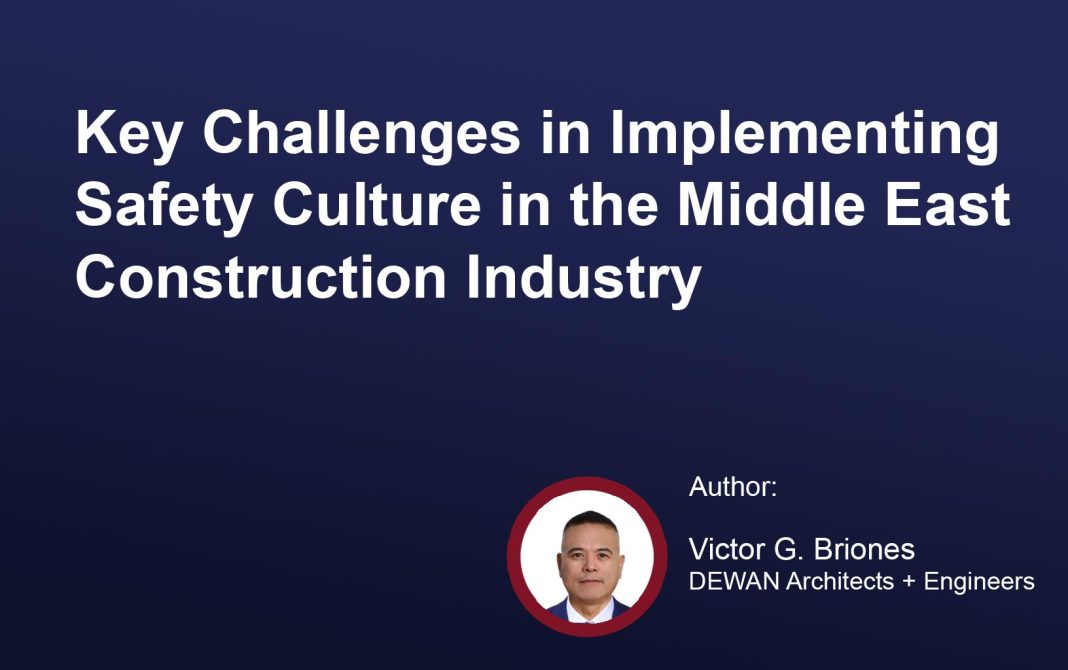In the dynamic construction environment of the Middle East, embedding a strong safety culture remains a significant challenge. Despite advancements in regulations and awareness, there continues to be a gap between policy and actual practice on-site. Drawing from over two decades of HSE leadership in the region, I believe there are five critical barriers we must urgently address.
1. Competency Gaps in Engineering and Safety Personnel
A major issue is the declining competency standards in both engineering and HSE roles. Many contractors hire fresh graduates or underqualified civil and MEP engineers who lack real-world understanding of their responsibilities in enforcing safety. Simultaneously, individuals from unrelated fields, such as drivers, office assistants, or security staff, transition into HSE roles after passing certifications like IGC NEBOSH.
While training and certification are important, they cannot replace practical field knowledge. These personnel, though certified, often lack the ability to influence site safety effectively—creating a dangerous assumption that “safety is covered,” when in reality, foundational understanding is missing.
2. Lack of Ownership Among Project Leaders
Another systemic issue is the absence of safety ownership from construction managers, project managers, and site foremen. Instead of integrating safety into daily operations, many shift the entire responsibility to the HSE department. They may speak about safety in client meetings, but fail to implement real actions on-site.
True safety culture can’t be delegated—it must be embedded in leadership behavior. When project leaders fail to lead by example, it signals to the workforce that safety is secondary, leading to poor compliance and rising incident risks.
3. Inadequate Budget Allocation for HSE
Budget limitations are a major hindrance, particularly for mid- and low-tier contractors. Some companies, in an attempt to win bids, cut HSE funding to the bare minimum, compromising everything from salaries for qualified professionals to investments in proper PPE and safe tools.
For example, dust exposure remains a chronic issue on many construction sites simply because companies avoid purchasing cement or block cutting tools with built-in dust suppression systems. These cost-driven decisions not only violate safety standards but also undermine workers’ health and site compliance. Only top-tier contractors tend to allocate sufficient HSE budgets. Smaller firms often treat safety as an afterthought—just enough to satisfy paperwork during audits—rather than a core operational priority.
4. Ineffective Safety Training and Knowledge Transfer
Toolbox talks and formal training programs are common, but their effectiveness is often limited. The root cause often lies with training providers. Some trainers are not technically competent or fail to tailor training to site realities. I’ve witnessed trainers presenting scaffolding safety slides without any hands-on demonstrations. In another case, a fire marshal trainer demonstrated how to cover an LPG fire with a blanket, ignoring real construction fire hazards like electrical panels or flammable materials.
Language barriers further reduce training effectiveness. A non-native speaker delivering technical sessions to a multilingual workforce, without proper translation or cultural understanding, results in poor knowledge retention.
5. Misalignment Between Compliance and Intent
Many safety programs exist to fulfill legal or client requirements but lack genuine commitment. Documentation may be complete, but the spirit of implementation is absent. This is especially evident when safety becomes a paper exercise rather than a behavior-driven initiative.
To shift from a compliance culture to a performance culture, companies must not only meet regulatory requirements but also demonstrate proactive leadership, transparent reporting, and investment in continuous improvement.
Path Forward: Building a True Safety Culture
To address these challenges, a few critical changes are needed:
· Prioritize Competency: Hiring should focus not just on certification but on relevant field experience and communication skills—especially for HSE roles.
· Leadership by Example: Project leaders must visibly champion safety, not just talk about it in meetings. Accountability starts at the top.
· Invest in Safety: Contractors should treat HSE budgets as part of core project requirements—just like materials or manpower—not as negotiable overhead.
· Revamp Training Quality: Regulatory bodies should certify trainers not just on credentials but on field relevance and delivery capability. Practical, hands-on training should be mandatory.
· Measure Intent, Not Just Compliance: Organizations should set internal KPIs that reflect real-world safety behavior, including leadership engagement, worker participation, and corrective action rates.
Conclusion
Creating a strong safety culture requires more than policies and PPE. It requires commitment, investment, and a shift in mindset—where every team member, from top management to trade workers, shares ownership of safety outcomes.
As HSE professionals across the region, we must continue to challenge ineffective norms, advocate for higher standards, and, most importantly, lead by example. Because safety isn’t just a requirement—it’s a responsibility we owe to every person who steps onto our worksites.
About the Author
Victor G. Briones is a certified HSE professional with over 22 years of experience across Saudi Aramco, Qatar Petroleum, and major UAE-based developments. His expertise spans oil & gas construction, substations, tunnels, roads, high-rise buildings, and events and exhibitions. He is passionate about safety leadership, competency development, and creating impactful HSE strategies across the Middle East.






